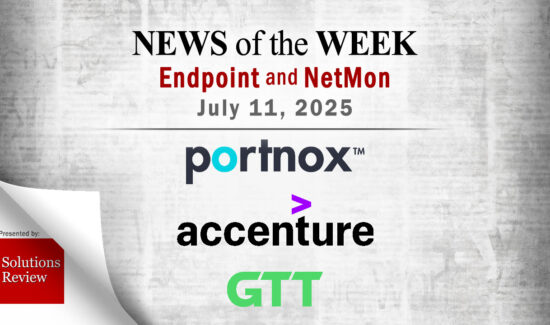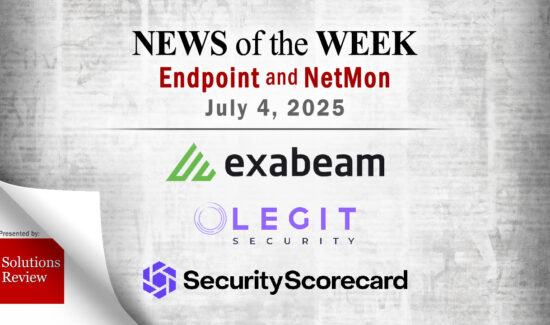Endpoint Security and Network Monitoring News for the Week of August 9; NetRise, OPSWAT, Legit Security, and More


The editors at Solutions Review have curated this list of the most noteworthy endpoint security and network monitoring news for the week of August 9. This curated list features endpoint security and network monitoring vendors such as NetRise, OPSWAT, Legit Security, and more.
Keeping tabs on all the most relevant endpoint security and network monitoring news can be a time-consuming task. As a result, our editorial team aims to provide a summary of the top headlines from the last month in this space. Solutions Review editors will curate vendor product news, mergers and acquisitions, venture capital funding, talent acquisition, and other noteworthy endpoint security and network monitoring news items.
Endpoint Security and Network Monitoring News for the Week of August 9
INTERPOL Helps Recover Over 40 Million USD from International Email Scam
A global stop-payment mechanism developed by INTERPOL has helped Singapore authorities make their largest ever recovery of funds defrauded in a business email compromise scam. On July 23 2024, a commodity firm based in Singapore filed a police report stating that they had fallen victim to a business email compromise scam, in which a scammer obtains access to or impersonates a business email account to deceive employees into transferring money to their bank account. On July 15, the firm had received an email from a supplier requesting that a pending payment be sent to a new bank account based in Timor Leste. The email, however, came from a fraudulent account spelled slightly different to the supplier’s official email address. Unaware, the firm transferred 42.3 million USD to the fake supplier on July 19, only discovering the crime four days later when the genuine supplier said it had not been paid.
NetRise Announces Major Platform Expansion
NetRise, an Extended Internet of Things (XIoT) security solutions provider, this week announced a significant expansion of its platform. Designed for those who build, buy, use, and maintain software, the NetRise Platform now supports the analysis of containers and Windows software assets. This development helps organizations to achieve comprehensive visibility across their software supply chain. It assists product and information security teams to inventory and control software assets and proactively respond to security risks when necessary to strengthen their software supply chain security posture using informed data-driven decisions.
SentinelOne and Intezer Team Up on Reverse Engineering of Rust Malware Project
SentinelOne, a global leader in cybersecurity solutions, and Intezer, a leader in AI-powered technology for autonomous security operations, this week launched a project aimed at illuminating the blind spot surrounding Rust malware so that threat researchers can better understand and accurately characterize the complex malware ecosystem before it reaches critical mass and blindsides the industry. As part of the initiative, researchers from SentinelLabs and Intezer have teamed to develop a methodology to make reverse engineering Rust malware more approachable and engage the security community to create and release tools to tackle the problem head on. Details of the project, known as OxA11C, were unveiled this week at Black Hat 2024. “In malware analysis, the arrival of a new programming language introduces an entirely new set of challenges that obstruct our ability to quickly grasp the malicious intent of a threat actor,” said Juan Andrés Guerrero-Saade, AVP of Research, SentinelLabs. “With the current state of our tooling, Rust is practically impossible to reverse engineer, and as a result, many analysts are shying away from researching the Rust malware ecosystem. Together with Intezer, we aim to change this.”
OPSWAT Acquires InQuest
Critical infrastructure protection (CIP) cybersecurity solutions company OPSWAT announced its acquisition of InQuest, a cybersecurity solutions provider known for its novel Deep File Inspection and RetroHunting technologies. InQuest is highly regarded for protecting Department of Defense (DoD) customers with its network appliances that peer up to and beyond Layer 7, and combined with their threat intelligence solutions, have a proven track record of protecting the nation’s most critical networks. OPSWAT’s relationship with InQuest has significantly grown since their technology partnership was established in 2013 when OPSWAT’s MetaDefender module was integrated with InQuest’s Network Detection and Respond solution for a joint customer at the Pentagon. “The combination of InQuest’s technology with OPSWAT’s MetaDefender platform will enhance the efficacy of threat intelligence and prevention, further enabling federal organizations and other critical sectors to operate securely and efficiently,” Benny Czarny, founder and CEO of OPSWAT, said in a media statement. “I have personally worked with Michael Arcamone for more than 10 years and I am excited to take our partnership to the next level. Together, we will accelerate our commitment to providing critical organizations with comprehensive, prevention-based protection against evolving threats.”
Contrast Security Introduces Application Detection and Response (ADR) Platform
Contrast Security, an appsec solutions provider, this week introduced Application Detection and Response (ADR). Contrast Security ADR helps security teams to identify vulnerabilities, detect threats, and stop attacks that target custom applications and APIs. ADR was officially announced this week at Black Hat USA 2024. “Companies have invested in detection and response capabilities across the network, including EDR (endpoint), NDR (network), CDR (cloud) and ITDR (identity threat) and are gaining even greater security control using XDR and next-gen SIEM solutions. But attackers continue to leverage gaps in applications and APIs. ADR closes that critical gap and blocks many zero-day attacks by removing these vulnerable blind spots,” said Rick Fitz, CEO of Contrast Security.
Legit Security Launches “Industry-First” AI Security Command Center
This week, Legit Security announced the launch of the “industry’s first” AI Security Command Center. This new, dedicated AI security dashboard provides security teams with a unified console to proactively gain visibility to AI used in development and defend against cyberattacks exploiting AI-based applications. “We’re excited to unveil Legit AI Security Command Center, a clear sign of our commitment to our rapidly growing customer base and their journey with GenAI,” said Roni Fuchs, CEO and Co-Founder of Legit Security. “AI is everywhere now, and developers are adopting it faster than ever to boost their productivity. At Legit Security, we’re all about helping developers move faster while keeping security rock-solid. Adding advanced AI security to our platform was the natural next step. This move really cements our ASPM platform as the go-to choice for any software-driven enterprise.”
Expert Insights Section
 Watch this space each week as our editors will share upcoming events, new thought leadership, and the best resources from Insight Jam, Solutions Review’s enterprise tech community for business software pros. The goal? To help you gain a forward-thinking analysis and remain on-trend through expert advice, best practices, trends and predictions, and vendor-neutral software evaluation tools.
Watch this space each week as our editors will share upcoming events, new thought leadership, and the best resources from Insight Jam, Solutions Review’s enterprise tech community for business software pros. The goal? To help you gain a forward-thinking analysis and remain on-trend through expert advice, best practices, trends and predictions, and vendor-neutral software evaluation tools.
US Government Agencies Continue to Be Heavily Targeted
“While the number of confirmed attacks we’ve tracked in the US this year so far is a reduction on the number noted in 2023, attacks on US government entities haven’t followed this same trend. Rather, this year we have noted 57 confirmed attacks on US government organizations, while 78 were noted throughout all of 2023. The average ransom across these attacks this year is $750,000.
This latest attack on Sumter County Sheriff’s Office joins the City of North Miami and the City of Killeen which have also confirmed attacks this month already.
Ransomware attacks on governments focus on causing as much disruption as possible by crippling key systems and preventing access to vital records. This helps increase the threat actors’ chances of securing a payment. A key example was the January attack on Washington County where an unknown group of hackers secured a $400,000 ransom after encrypting systems.
We have also tracked 21 unconfirmed attacks on US government organizations this year so far.”
-Rebecca Moody, Head of Data Research at Comparitech



















